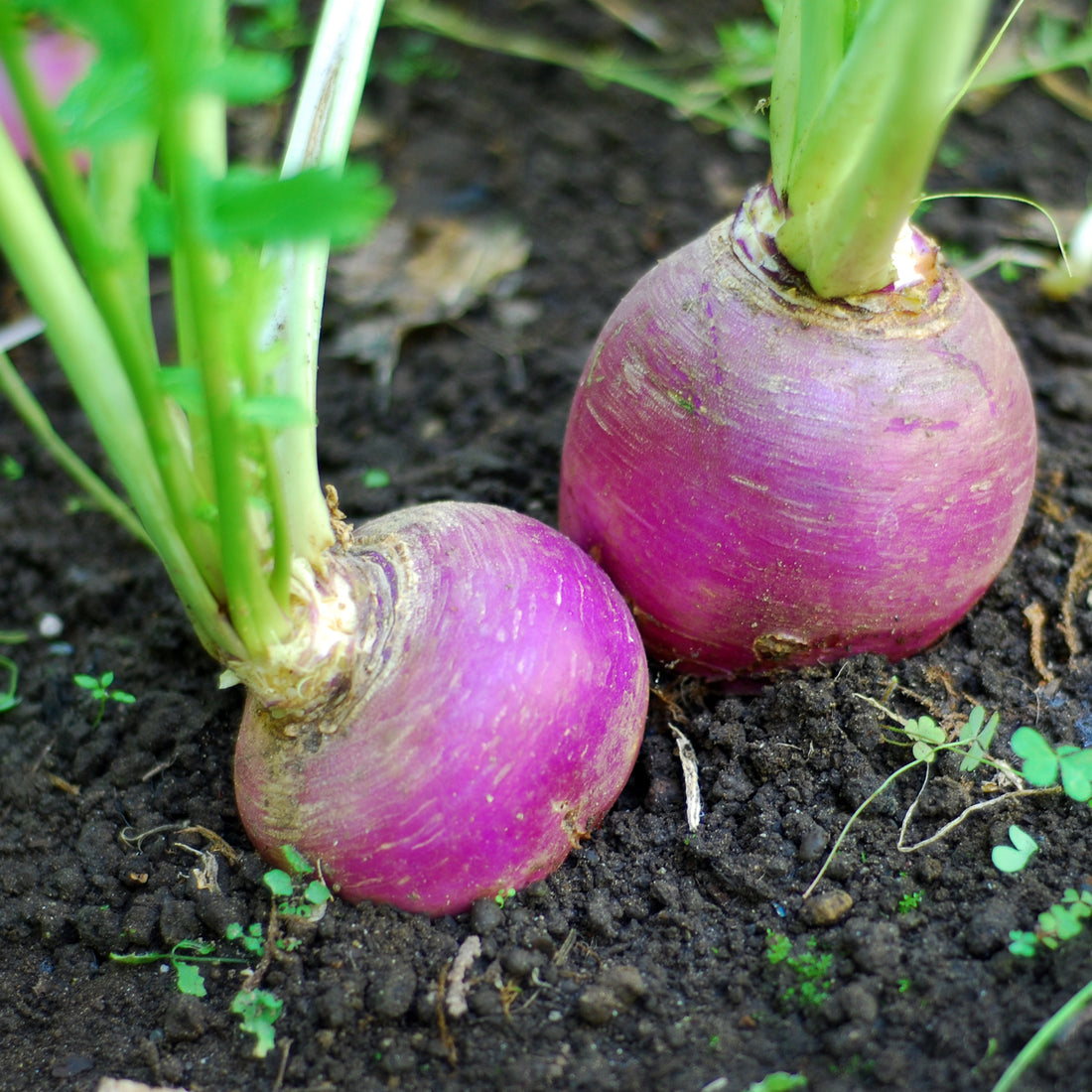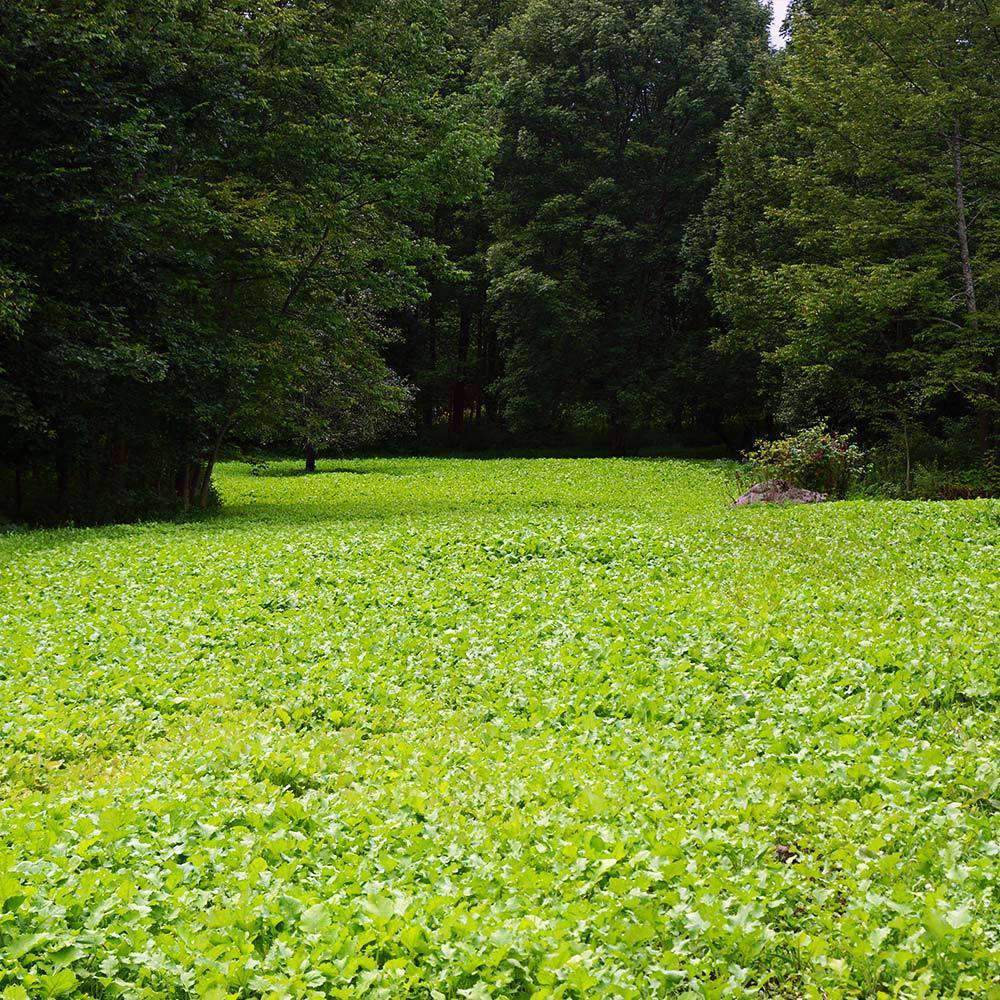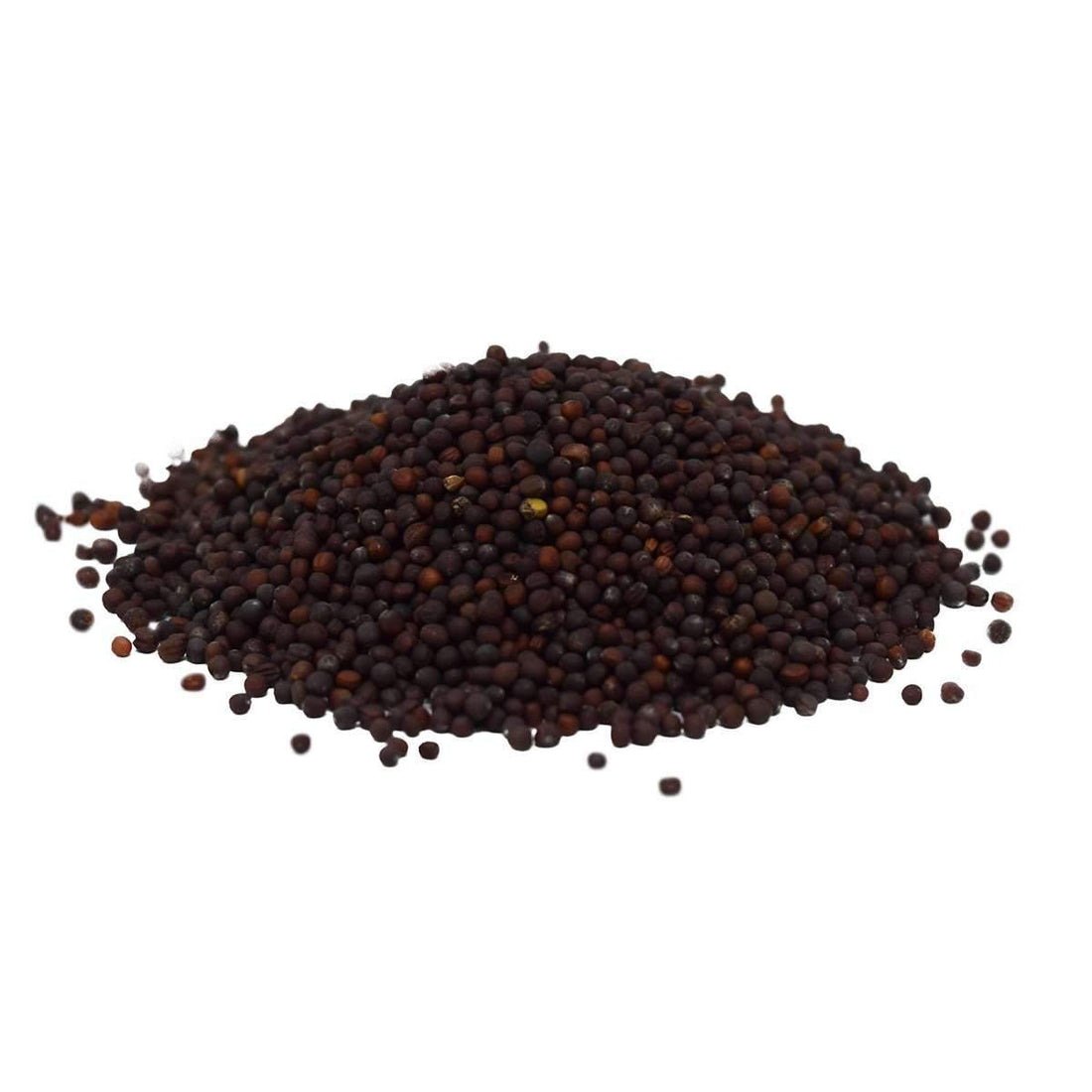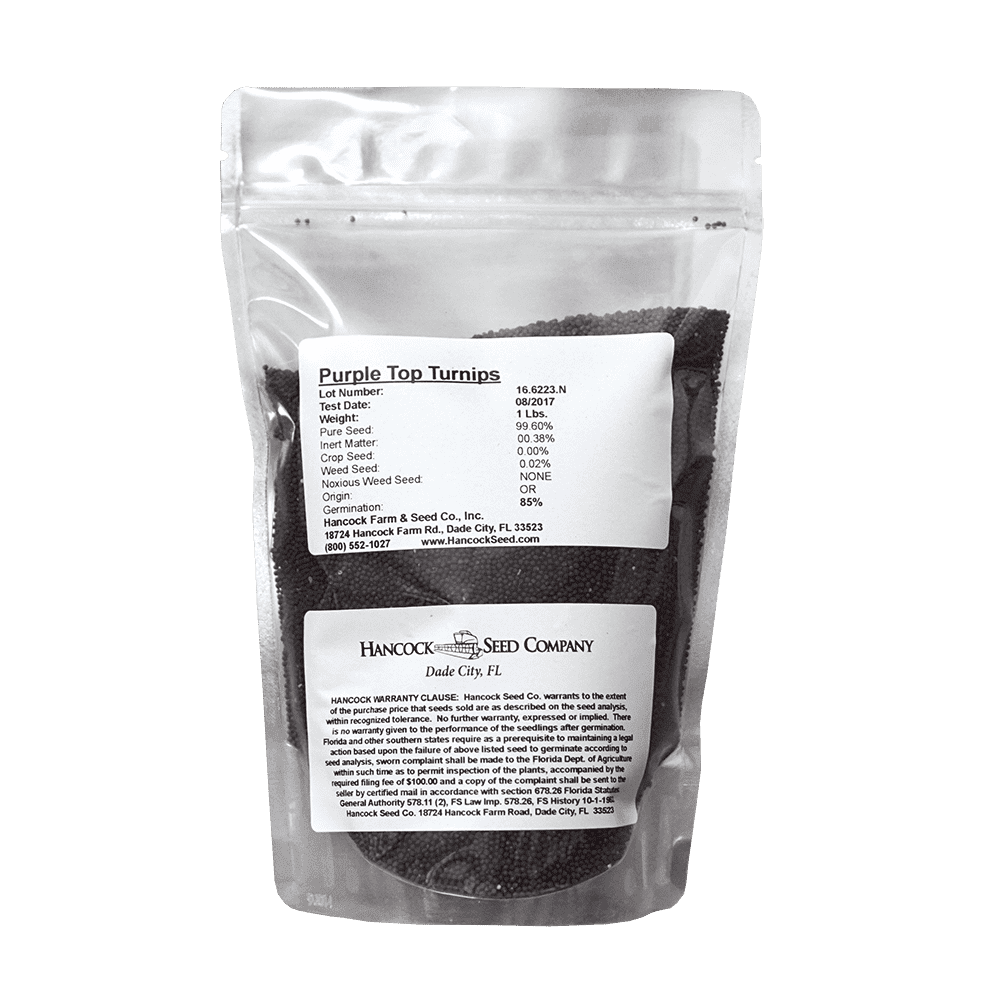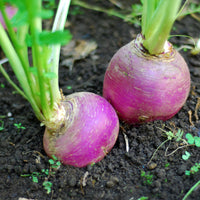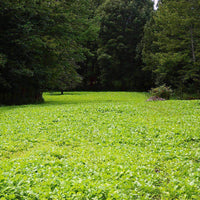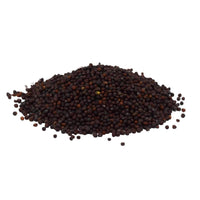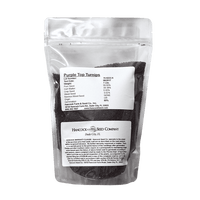
- When to plant:
- Spring, Fall, Winter
- Fertilizer:
- Varies
- Seeding rate:
- 10 lbs. per acre
- Seeding depth:
- 1/8 - 1/4 inch
- Ideal ph:
- 5.5 - 6.5
- Gmo:
- No
- Inoculant needed:
- No
- Coated or raw:
- Raw
- Lifecycle:
- Annual
- Climate zones:
- Cool Season, Transition Zone, Warm Season
Purple Top Turnips are generally tolerant of freezing weather, and their roots can be stored for a fairly long period of time in cold storage conditions. Rutabagas or Swedish Turnips ("Swedes ") tend to be somewhat larger, sweeter and less strongly flavored than Turnips. Also, their flesh is a yellowish creamy color. Turnips have a crisp white flesh and a zesty mustard-like flavor.
Product Information
- Application or Use: Pasture, Cattle Grazing, Food Plot, Cover Crop
- Germination Time: 5 - 7 days, under optimal conditions
- Growing Locations: Warm Season, Transition Zone, Cool Season
- Height: Up to 2 feet
- Sunlight Requirements: 4+ hours
- Advantages: Provides soil fixation along with being an excellent source of protein for deer and other wildlife.
- When to Plant: Recommended planting time is spring and fall when night time temperatures are consistently below 65 degrees.
Product Detail
-
Wildlife food plots
- Well drained soil
- Cold hardy
- Thrives in many types of soil
- Brassica, cover crop
Product Information
Although these crops will stand some heat, they are normally considered cool-weather crops. Plant them in late Winter or early Spring for a spring crop or in the late Summer for a Fall or Winter crop. The seeds of Turnip are very small. The seedlings are fairly small and delicate as well. Scatter the seeds and rake them in or plant them thickly in a straight, narrow line. Cover the seeds about 1/2 in. deep. Very thick stands will have to be thinned to allow for good root formation. To ensure good germination and emergence, frequent, light watering may be needed. Crusty soils will retard emergence and a poor stand may result in these soils.
If the weather is dry, irrigation during the root development stage will give the best quality roots.
Early season weed control is essential. When rows are used, shallow cultivation and hoeing are effective. In a wide bed, pulling the weeds is sometimes the only solution. This should be done when the weeds are very small. Hoeing and cultivation also keep the soil loose and friable around the plants, enabling them to produce large, well-shaped roots.
Turnips will thrive in many types of soil. A loose, friable loam will allow the best root size and formation. Good drainage is essential, but dry soils should be avoided unless irrigation is planned. Soils of moderate fertility will produce the best crop, although proper fertilization and pH adjustment can overcome lack of natural fertility.
*Product packaging may appear different than what is pictured.
Plant in the fall or spring at a rate of 5 - 10 lbs per acre. This seed needs to be at a depth of 1/8 - 1/4 and prefer a pH of 5.5 - 6.5.
A soil test should be taken to determine the soil pH and nutrients needs. The optimum pH for turnip production is 6.0 to 6.5. Apply lime according to soil test recommendations at least three months prior to planting, to adjust the pH to the proper level.
Soils that are infested with root-knot nematodes should be avoided particularly for the Fall crop; these pests will cause deformed roots. Do not plant Turnips after other cole crops.
A soil test is always the best method for determining the fertilization needs of a crop. Add additional nitrogen when the young plants begin to put on "true leaves," or after a heavy rainfall. Avoid applying too much nitrogen, which will reduce root formation. Broadcast fertilizer over the whole planting area a few days before seeding. Sidedress applications should be placed at least 3 in. away from the seed row.
When choosing to start a new lawn, remove old vegetation by using a de-thatcher, power rake or tiller to kill the existing vegetation. Rake or drag the area to remove debris and dead grass for a clean area. Ensure the soil is leveled and loosened to allow the seed to have good soil contact once spread on a clean seed bed.
If you have an area with heavy weed coverage, we recommend starting fresh by killing and removing the existing vegetation. If you choose to use chemicals, herbicides or fertilizers, you must check with the product's manufacturer prior to planting new seed to ensure the proper waiting period.
When overseeding an existing area, mow your lawn at the lowest setting and bag the clippingsx. Rake or drag any areas that have dead thatch or debris.

Seed Quality
Hancock Seed is dedicated to delivering the best seeds possible to our customers. Hancock Seed grows and harvests many of our products, and we acquire the majority of the rest from other family farmers.
All these seeds are processed, packaged and shipped from Hancock Farm. This helps us ensure that our high standards are met. Unlike much of the competition, we refuse to sell you a seed that was not gathered during the last harvest. You will always receive fresh product from Hancock.
Every seed we grow comes with 40 years of experience behind it...you can rest assured that all of our products are cultivated in a method that assures its potential for growth.

Your cart ( 0 )

Purple Top Turnips are generally tolerant of freezing weather, and their roots can be stored for a fairly long period of time in cold storage conditions. Rutabagas or Swedish Turnips ("Swedes ") tend to be somewhat larger, sweeter and less strongly flavored than Turnips. Also, their flesh is a yellowish creamy color. Turnips have a crisp white flesh and a zesty mustard-like flavor.
Product Information
- Application or Use: Pasture, Cattle Grazing, Food Plot, Cover Crop
- Germination Time: 5 - 7 days, under optimal conditions
- Growing Locations: Warm Season, Transition Zone, Cool Season
- Height: Up to 2 feet
- Sunlight Requirements: 4+ hours
- Advantages: Provides soil fixation along with being an excellent source of protein for deer and other wildlife.
- When to Plant: Recommended planting time is spring and fall when night time temperatures are consistently below 65 degrees.
Product Detail
-
Wildlife food plots
- Well drained soil
- Cold hardy
- Thrives in many types of soil
- Brassica, cover crop
Product Information
Although these crops will stand some heat, they are normally considered cool-weather crops. Plant them in late Winter or early Spring for a spring crop or in the late Summer for a Fall or Winter crop. The seeds of Turnip are very small. The seedlings are fairly small and delicate as well. Scatter the seeds and rake them in or plant them thickly in a straight, narrow line. Cover the seeds about 1/2 in. deep. Very thick stands will have to be thinned to allow for good root formation. To ensure good germination and emergence, frequent, light watering may be needed. Crusty soils will retard emergence and a poor stand may result in these soils.
If the weather is dry, irrigation during the root development stage will give the best quality roots.
Early season weed control is essential. When rows are used, shallow cultivation and hoeing are effective. In a wide bed, pulling the weeds is sometimes the only solution. This should be done when the weeds are very small. Hoeing and cultivation also keep the soil loose and friable around the plants, enabling them to produce large, well-shaped roots.
Turnips will thrive in many types of soil. A loose, friable loam will allow the best root size and formation. Good drainage is essential, but dry soils should be avoided unless irrigation is planned. Soils of moderate fertility will produce the best crop, although proper fertilization and pH adjustment can overcome lack of natural fertility.
*Product packaging may appear different than what is pictured.
Plant in the fall or spring at a rate of 5 - 10 lbs per acre. This seed needs to be at a depth of 1/8 - 1/4 and prefer a pH of 5.5 - 6.5.
A soil test should be taken to determine the soil pH and nutrients needs. The optimum pH for turnip production is 6.0 to 6.5. Apply lime according to soil test recommendations at least three months prior to planting, to adjust the pH to the proper level.
Soils that are infested with root-knot nematodes should be avoided particularly for the Fall crop; these pests will cause deformed roots. Do not plant Turnips after other cole crops.
A soil test is always the best method for determining the fertilization needs of a crop. Add additional nitrogen when the young plants begin to put on "true leaves," or after a heavy rainfall. Avoid applying too much nitrogen, which will reduce root formation. Broadcast fertilizer over the whole planting area a few days before seeding. Sidedress applications should be placed at least 3 in. away from the seed row.
Instructions
When choosing to start a new lawn, remove old vegetation by using a de-thatcher, power rake or tiller to kill the existing vegetation. Rake or drag the area to remove debris and dead grass for a clean area. Ensure the soil is leveled and loosened to allow the seed to have good soil contact once spread on a clean seed bed.
If you have an area with heavy weed coverage, we recommend starting fresh by killing and removing the existing vegetation. If you choose to use chemicals, herbicides or fertilizers, you must check with the product's manufacturer prior to planting new seed to ensure the proper waiting period.
When overseeding an existing area, mow your lawn at the lowest setting and bag the clippingsx. Rake or drag any areas that have dead thatch or debris.















